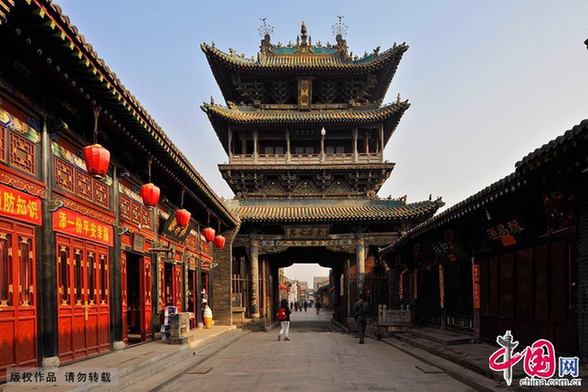Cultural identity of Pingyao endangered by tourism
 0 Comment(s)
0 Comment(s) Print
Print E-mail Xinhua, November 4, 2014
E-mail Xinhua, November 4, 2014
The local customs and cultural heritage of the ancient town of Pingyao in Shanxi Province is under threat due to the rapid development of tourism.
In the 17 years since the 2,700-year-old town was added to UNESCO's World Heritage List, it has seen tourism develop at a meteoric pace, with its tourism revenue growing from 12.5 million yuan (2.04 million U.S. dollars) in 1997 to 5.416 billion yuan in 2013.
Business opportunities afforded by the blossoming of tourism has resulted in the transformation of traditional dwellings along the town's main drag into hostels, souvenir shops, eateries and bars.
Many tourists complain that the ancient town is losing its serenity and unique style.
Zhang Peng, an associate professor of architecture with Tongji University in Shanghai, said the future of a heritage site should be based on the collective willingness of all interest groups. However, in Pingyao, local residents often feel disenfranchised.
Every ancient town should find a development pattern that is in accordance with its own characteristics, and the local governments should control commercial activities deemed to be against the traditional characteristic of the town, he said.
Hou Shijun, head of the tourism bureau of Pingyao County, said: "Some businesses may indeed damage the traditional cultural heritage. The government is currently working on the issue of market access, and we should not allow the ancient town to become a cultural hodgepodge."
Unreasonable demographic structure is also a threat to the cultural heritage of Pingyao.
According to county deputy head Hu Jinliang, in 1997 the population of the 2.25-square-kilometer town was 45,000, yet the density was about 16 times of that of Beijing.
In response, the local government has moved many public institutions and enterprises out of town, with the purpose of transforming it from a community to a tourist site.
Local residents have also been leaving the area due to inconvenient transportation and substandard living conditions.
Local resident Gao Guihong said: "It is too humid in the house. There is no big supermarket, school or hospital in the town, and the air is also bad since we still use coal for heating."
Gao, 45, said that in an effort to save enough money to finance a move out of the county, has found work as a waiter in a hostel and is also employed part-time as a masseuse.
Ji Taiping, director of the county's urban-rural planning bureau, said that since the number of local residents emotionally attached to the traditional houses decreased and the number of tourists and newcomers grew the ancient town had begun to slowly lose its vigor and vitality.
The current situation also threatens the protection of traditional structures as this influx of outsiders usually lack any interest in protecting or restoring the houses, Ji said.
The local government should regulate the development of tourism and improve infrastructure and living conditions for local residents, he added.
The county has 3,797 traditional dwellings and other historical sites within its 6.4-km-long walls. But only about 400 are well-preserved and the majority are dilapidated due to a lack of adequate protection, said county chief Cao Zhisheng.
The protection of the buildings in this ancient town should develop alongside improvements for the local residents, Zhang Peng said.







Go to Forum >>0 Comment(s)